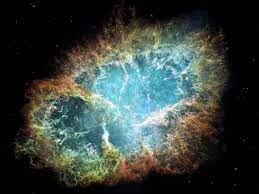
Various civilizations recorded supernovae long before the telescope was invented in the 17th century. The oldest recorded supernova is RCW 86, which Chinese astronomers spotted in A.D. 185. Their records show that this “guest star” stayed in the sky for eight months, according to NASA.
The Crab Nebula, arguably the most famous supernova, was first spotted by Chinese and Korean astronomers who recorded this star explosion in their records in 1054. Native Americans may have seen it as well, according to rock paintings found in Arizona and New Mexico. The supernova that formed the Crab Nebula was so bright that those early astronomers could see it during the day.
Other supernovae that were observed before the telescope was invented occurred in the years 393, 1006, 1181, 1572 (studied by famed astronomer Tycho Brahe) and 1604. Brahe wrote about his observations of the “new star” in his book, “De nova stella,” which gave rise to the name “nova.”
The term “supernova” was first used by Walter Baade and Fritz Zwicky at Mount Wilson Observatory, who used it in relation to an explosive event they observed, called S Andromedae (also known as SN 1885A), located in the Andromeda Galaxy. The scientists suggested that supernovas happen when ordinary stars collapse into neutron stars.
When stars die
On average, a supernova will occur once every 50 years in a galaxy the size of the Milky Way, according to research by the European Space Agency. This means a star explodes every 10 seconds or so somewhere in the universe, according to the U.S. Department of Energy.
About 10 million years ago, a cluster of supernovae created the “Local Bubble,” a 300-light-year long, peanut-shaped bubble of gas in the interstellar medium that surrounds our solar system.
Exactly how a star dies depends in part on its mass. Our sun, for example, doesn’t have enough mass to explode as a supernova. (Though the news for Earth still isn’t good, because once the sun runs out of its nuclear fuel, perhaps in a couple billion years, it will swell into a red giant that will likely vaporize our world, before gradually cooling into a white dwarf.) But with the right amount of mass, a star can burn out in a fiery explosion.
A star can go supernova in one of two ways:
Type I supernova: star accumulates matter from a nearby neighbor until a runaway nuclear reaction ignites.
Type II supernova: star runs out of nuclear fuel and collapses under its own gravity.
Type II supernovae
Let’s look at the more exciting Type II first. For a star to explode as a Type II supernova, it must be several times more massive than the sun (estimates run from eight to 15 solar masses). Like the sun, it will eventually run out of hydrogen and then helium fuel at its core. However, it will have enough mass and pressure to fuse carbon.
Next, gradually heavier elements build up at the center, and the star forms onion-like layers of material, with elements becoming lighter toward the outside of the star. Once the star’s core surpasses a certain mass (called the Chandrasekhar limit), it begins to implode. For this reason, these Type-II supernovae are also known as core-collapse supernovae.
Eventually the implosion bounces back off the core, expelling the stellar material into space, forming the supernova. What’s left is an ultra-dense object called a neutron star, a city-sized object that packs the mass of the sun in a small space.
Type II supernova sub-categories are classified based on their light curves, which describes how the intensity of the light changes over time. The light of Type II-L supernovae declines steadily after the explosion, while the light of Type II-P supernovae stays steady for a longer period before diminishing. Both types have the signature of hydrogen in their spectra.
Stars much more massive than the sun (around 20 to 30 solar masses) might not explode as a supernova, astronomers think. Instead they collapse to form black holes.
Type I supernovae
Type I supernovae lack a hydrogen signature in their light spectra and are generally thought to originate from white dwarf stars in a close binary star system. As the gas of the companion star accumulates onto the white dwarf, the white dwarf is progressively compressed, and eventually sets off a runaway nuclear reaction inside that eventually leads to a cataclysmic supernova outburst.
Astronomers use Type Ia supernovae as “standard candles” to measure cosmic distances because all are thought to blaze with equal brightness at their peaks.
Type Ib and Ic supernovae also undergo core-collapse just as Type II supernovae do, but they have lost most of their outer hydrogen layer. In 2014, scientists detected the faint, hard-to-locate companion star to a Type Ib supernova. The search consumed two decades, as the companion star shone much fainter than the bright supernova.
Watching a supernova
Recent studies have found that supernovae vibrate like giant speakers and emit an audible hum before exploding.
In 2008, scientists caught a supernova in the act of exploding for the first time. While peering at her computer screen, astronomer Alicia Soderberg expected to see the small glowing smudge of a month-old supernova. But what she and her colleague saw instead was a strange, extremely bright, five-minute burst of X-rays.
With that observation, they became the first astronomers to catch a star in the act of exploding. The new supernova was named SN 2008D. Further study has shown that the supernova had some unusual properties.
“Our observations and modeling show this to be a rather unusual event, to be better understood in terms of an object lying at the boundary between normal supernovae and gamma-ray bursts,” Paolo Mazzali, an Italian astrophysicist at the Padova Observatory and Max-Planck Institute for Astrophysics, told Space.com in a 2008 interview.





